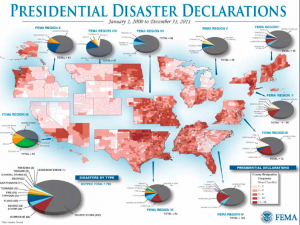September is National Preparedness Month, and choosing the well-remembered Sept. 11 date to launch a series of preparedness webinars may have been a good way to drive home the “preparedness” message.
On Wednesday Agility Recovery and the United States Small Business Administration launched a webinar series to educate business leaders on the importance of business preparation in advance of natural or manmade disasters. It’s the 10th year the two organizations have combined their outreach efforts to help Americans become more aware of the need for disaster and emergency planning.
“Protect Your Organization by Preparing Your Employees” was the title of Wednesday’s webinar, which was presented by Joseph Loddo, deputy associate administrator for SBA’s Office of Disaster Assistance, and Bob Boyd, Agility’s president and CEO.
Referring to the anniversary of the Sept. 11, 2001 terrorist attacks Boyd said at least one good thing that came out of that tragedy.

“If there was one good event that came out of that horrible day it was the realization was there are lots of things we can do,” he said, as he offered a list of ideas to make businesses and families feel more secured and prepared.
“There’s lots of things you can do to dramatically improve your local preparedness,” he said.
Thinking about impact of 9/11, he added, “We as a country outta put an amazing amount of resources into making sure that never happens again.”
Loddo referred to a more recent disaster to drive home the point, Hurricane Sandy.
“It’s hard to believe that its’ been nearly one year since Hurricane Sandy devastated parts of the Eastern Seaboard,” Loddo said.
According to Loddo, in the area affected by Sandy SBA approved more than 33,000 loans to homeowners and small busienss amounting to more than $2 billion.
However, he added, “many businesses are still struggling to recover.”
And disasters like Sandy bring with them a message for business owners, Loddo said.
“Prepare your company for any kind of crisis,” he said.
A large part of the webinar was dedicated to informing business owners how to get employees prepared.
“The reality is interruptions, disasters, crises, they simply happen every day,” Boyd said. “At the end of the day it really doesn’t matter what caused the event, being prepared, having a strategy, having your people know what to do what not to do, how to communicate with them, is so important to you and your stakeholders.”
Information provided on the webinar outlined some numbers on the lack of preparedness and the need to be prepared for disasters and emergencies:
- 15 to 40 percent of businesses fail following natural or manmade disaster;
- 35 percent of small to mid-size businesses have comprehensive disaster recovery plan;
- 94 percent of small business owners believe a disaster could seriously disrupt their business within the next two years;
- 51 percent of Americans have experienced at least one emergency situation involving lost utilities for at least three days, evacuation from their home or office, loss of communications with family members or have had to provide first aid to others.
Planning is important, but no matter how good a plan is it’s worthless without employees who have been trained to be ready follow that plan when disaster strikes, Boyd said.
“If you don’t have your team there ready to implement that (plan), you’re not going to be ready to recover, ready to get back up,” Boyd said, adding nor will you be able to take care of your customers’ needs.
Four steps to make sure employees are ready include ensuring:
1. They know the plan
2. Know where to find the plan
3. Know their primary role
4. They share the plan with new hires
Another piece of advice was to cross-train employees to maintain critical business functions, and some things to keep in mind in regard to those functions: Critical business functions must continue; certain areas/departments may experience greater demand; longer or odd hours may require additional staffing; employee absenteeism will spike.
The hosts of the webinar advised visiting www.PrepareMyBusiness.org for a more complete checklist of functions. Other recommended preparedness websites offered in the webinar included: www.Ready.gov; www.RedCross.org; www.Do1Thing.com.
Beside a plan for the workplace, it is also advisable to ensure employees have their own family plan.
“The best way to get your employees to come back to work is to make sure they have a plan at home,” Boyd said.
Employees should be encouraged by establish an evacuation or shelter plan, have a safe critical document storage space and an emergency kit at home. To encourage employees to tackle personal disaster planning businesses can offer workshops, checklists, emergency kits and family involvement days.
The next two webinars are: “The NEW Ten Steps for Preparedness,” on Sept. 18 from 2 p.m. to 3 p.m. EST;” and “Crisis Communications for Any Organization on Sept. 25 from 2 p.m. to 3 p.m. EST. Stay tuned to InsuranceJournal.com for coverage of both of those webinars.
Topics Training Development
Was this article valuable?
Here are more articles you may enjoy.


 FBI Involved After Two Florida Injury Lawyers Go Missing From Fishing Trip
FBI Involved After Two Florida Injury Lawyers Go Missing From Fishing Trip  Private Equity Firms Expected to Unleash Middle-Market M&A Deals, Survey Says
Private Equity Firms Expected to Unleash Middle-Market M&A Deals, Survey Says  Three Atlanta Firms Merge, Offering Range of Insurance and Financial Services
Three Atlanta Firms Merge, Offering Range of Insurance and Financial Services  Zurich and Players Health Form Injury Insurance for NIL Era of College Sports
Zurich and Players Health Form Injury Insurance for NIL Era of College Sports 

